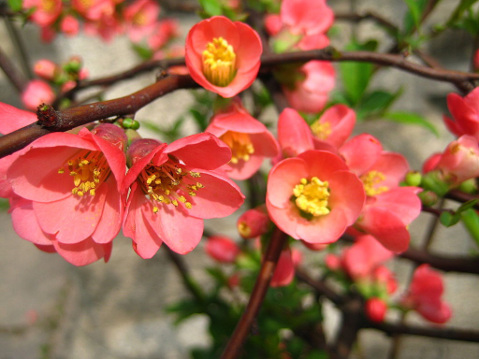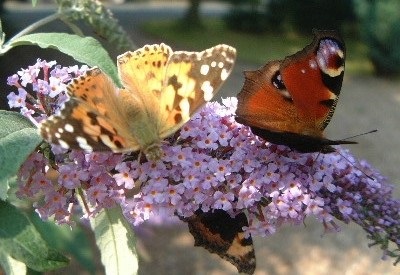July in the Garden
Shaping, Pinching, Planting, and Protecting

The garden chores in July are many, some pleasurable and some a bit tedious. Break them out into manageable blocks, and don’t stress about it. Take a break now and then, and use the opportunity to get a mild workout. Stretch those muscles that may not have been used in quite the same way for a while. Do stay hydrated, and don’t forget the sunscreen.
Needless to say, everyone must manage irrigation water wisely through these dry months in this drought year. But, remember that plants also actively transport water up from their roots and release it through their leaves even on humid days. Probe the soil and water as needed. Check mulch levels, and renew as needed to maintain 2 to 4 inches covering the soil. Mulch can significantly cut down on water use, and it feeds the soil, which then feeds the plants.
This month it is okay to do some light pruning to shape deciduous trees and shrubs. Fruit trees and their flowering relatives, ornamentals such as jacaranda, coral trees (Erythrina species) and liquidambar, as well as roses and other shrubs like rose of Sharon (Hibiscus syriacus) and flowering quince (Chaenomeles species) can benefit from this treatment. Other species that benefit from some judicious pinching are perennials that bloom in the fall such as chrysanthemums. The topmost branches of foliage plants like coleus and plectranthus should also be pinched to force the development of side shoots. Top leafy herbs such as basil, thyme, and sage, too. It will keep them producing more leafy growth instead of diverting their resources into creating flowers.

Many plants grown for their flowers will respond with another bloom cycle if they are cut back in midsummer. These include shrubs like princess flower (Tibouchina urvilleana), butterfly bush (Buddleja davidii) and tuberous plants like cannas.
Continue to plant warm season species such as citrus, avocado and cherimoya. It’s the perfect time to plant bauhinia, tabebuia, hibiscus, and even plumeria. The warmth-loving subjects such as bougainvillea, passion vine, and trumpet vine are also happiest when they go into the ground in summer. Choose and plant daylilies now while they are flowering. Continue successive plantings of summer vegetables like tomatoes, peppers, corn, and squash and annual flowers that will provide nearly instant color in beds and pots.
Protect fruit on trees with bird netting, or hang flashing and fluttering Mylar strips or pinwheels to scare them off. Bird netting can also be laid over rows of tender crops like lettuce if cottontail rabbits have found your garden grocery. Gophers are always a scourge, so protect new plantings with cages for their roots. Chicken wire is easily formed into cylinders (be sure to crimp the bottom firmly shut) or buy ready-made cages at the nursery.
Pests to watch for are giant whitefly — wash eggs and larvae off with water or, if they get ahead of you, horticultural soap solution. Watch for various types of caterpillars chewing on geraniums, cabbage family plants, or tomatoes — pick them off and/or spray with Bt (Bacillus thuringiensis). Aphids appear almost any time of year — wipe them off by hand, or spray them off with a blast from the hose.



